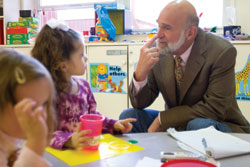Writing the Book on Language
“The world was so new that there were no names for many things; so all the people could do was point.”
That line, from Gabriel Garcia Marquez’s novel One Hundred Years of Solitude, is one of Doug Greer’s favorite analogies for how human beings develop language skills. For the past 40 years, Greer – Professor of Psychology and Education at TC, and a disciple of the late behavioral psychologist B.F. Skinner – has quietly gone about the work of giving the gift of speech to young children with language delays resulting from either genetic causes (autism or other disorders) or environmental ones (the social deprivations that can attend severe poverty). He has founded schools in
Now he has produced two particularly compelling forms of validation for his work. The first is a book, Verbal Behavior Analysis: Inducing and Expanding New Verbal Capabilities in Children with Language Delays (Pearson Education, 2008), co-authored with his former graduate student (and former TC faculty member) Denise Ross, which provides a hands-on guide to teachers and parents who are trying to provide verbal capabilities to children. Like the CABAS method itself, the book offers a step-by-step process for imparting units of learning as seemingly basic as learning to ask for a cookie, using methods as seemingly primitive as leading a child through a “Simon says” series of movements that become associated with a word and the object it denotes. Yet these units, when absorbed, in fact represent huge leaps across a divide that separates learning, interacting children from those trapped by walls of silence.
Just as important as the protocols for teaching these behaviors is the system for documenting and measuring a child’s progress – both over a sustained period of time, but equally as important, from task to task, hour by hour, day by day. Such documentation is a staple at the schools Greer has founded in
Perhaps even more compelling, at least for a lay audience, than Greer’s book are new data on the progress of class of normally-developing second graders with whom he employed CABAS teaching methodology during the 2006-07 school year. The 17 children, who attended public school in
“These were supposed to be the toughest kids to teach because so many of them are poor, learning-disabled or speak English as a second language,” Greer says. “With the results like these, the question is no longer, ‘Can we close the achievement gap?’, but ‘Do we care enough to bother’?”
Published Wednesday, Dec. 12, 2007
